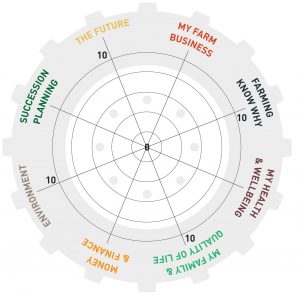
The Tractor Wheel of Life – a quick way to check the pulse of your business
“I’ll think of something.”
 That’s a farmer’s answer to every problem – and usually they do as they’re incredibly resourceful, talented people with an amazing work ethic. They do it until it comes to their own wellbeing.
That’s a farmer’s answer to every problem – and usually they do as they’re incredibly resourceful, talented people with an amazing work ethic. They do it until it comes to their own wellbeing.
Many of you reading the words ‘farmer’s wellbeing’ are probably starting to feel uncomfortable, a bit flushed and starting to fidget. But wellbeing is a problem every farmer needs to find an answer to. The question is: How?
Over the past three years, the nation has made fantastic progress in terms of discussing wellbeing and mental health, but we are talking about the 10% we see and the visible symptoms, when 90% of the problem is hidden.
So how do you deal with the 90%? What can you do when you see no way forward, no light at the end of the tunnel?
The Tractor Wheel of Life
 When you visit your GP, one of the first things they will do is take your temperature and check your blood pressure. The 2 Minute Farmer equivalent is the ‘Tractor Wheel of Life’, a quick, 2-minute exercise to gauge the pulse and shape of your business.
When you visit your GP, one of the first things they will do is take your temperature and check your blood pressure. The 2 Minute Farmer equivalent is the ‘Tractor Wheel of Life’, a quick, 2-minute exercise to gauge the pulse and shape of your business.
With the shape of your Tractor Wheel established, it is time to dig a little deeper behind your score for each of the spokes.
Spend a couple of minutes on each spoke and make a list of the reasons and factors behind each score – probably you will find it easy to jot down at least 3 reasons for each spoke of the wheel.
Eight spokes, 2 minutes on each, and you should have a list of 24 reasons why your wheel is not as smooth or round as it could be.
What do we do with these 24 reasons? How do we cope when there is so much to address, especially when many of us feel swamped by the pressures of 21st century life.
We need to find a way of easing the pressure and creating some space that allows the brain to think for itself and deal with challenges, as opposed to being swamped by them. It is a very short journey from feeling swamped to mental health issues developing.
Tame and wicked problems
 The theory of ‘tame’ and ‘wicked’ problems can help. A tame problem has a linear solution – an example would be changing the clutch on a tractor. There is only one solution to this, the work has to be done in a set order and you know when problem is solved.
The theory of ‘tame’ and ‘wicked’ problems can help. A tame problem has a linear solution – an example would be changing the clutch on a tractor. There is only one solution to this, the work has to be done in a set order and you know when problem is solved.
A wicked problem has no linear solution – the only way to find a solution is through trial and error. Maximising the milk yield from your dairy cows is an example. There are many different action you can take, but you will never really know if you have maximised yield.
Taking action
 So consider your 24 reasons from the tractor wheel and, alongside one, write if it’s a tame problem or a wicked problem. We then need 2 new lists – one for your tame and one for your wicked problems, in prioritised order.
So consider your 24 reasons from the tractor wheel and, alongside one, write if it’s a tame problem or a wicked problem. We then need 2 new lists – one for your tame and one for your wicked problems, in prioritised order.
For your top 6 tame problems, work out what the linear solution is and write down every step of the linear solution, together with a date by which you are going to complete each step. By taking the steps you have written down, you are making space in your brain to deal with the wicked problems.
So how do you deal with the wicked problems?
Are you familiar with the saying: ‘Go to sleep on a problem and when you wake up you will have the answer’? Distracting yourself for a few minutes with something else or, even better, sleeping on a problem until the next day can help the brain come up with the ideal solution.
So don’t actively work on your wicked problems, but each day read through what your top 3 are.
Meanwhile, by addressing the tame problems, you are freeing up space in the brain for it to work subconsciously on finding potential solutions to the wicked ones.
By approaching it in this way, you will find that solutions suddenly spring to the front of your mind. The solutions are still a case of trial and error, but are usually effective in beginning to address the wicked problems.
Keep working your way down through the problems on your lists and, every 3-4 months, have another go at the tractor wheel and repeat the process.
The tame and wicked problem approach isn’t a panacea for addressing all the challenges facing farmers and farming, but it’s certainly a start.
It’s a step in the right direction to taking control of more aspects of your life.